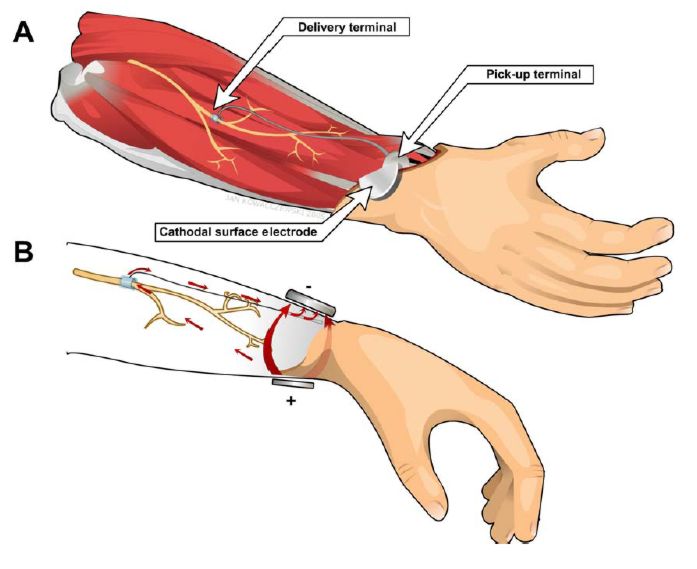The StimRouter
The StimRouter System is a novel neural prosthesis. It comprises an implanted lead that picks up some of the current delivered through the skin by a surface stimulator and delivers it to a target nerve. The concept was tested and patented by Arthur Prochazka in 2004. Animal tests showed that the system could activate deep target nerves without activating local nerves under the surface electrodes.

In 2008 the first human implant of a StimRouter took place at the University of Alberta in Edmonton. Leads were implanted on nerves innervating paralyzed hand muscles in a man with quadriplegia.The external pulse generator and surface electrodes were located in a wristlet. Hand opening and closing were controlled via a wireless earpiece that detected tooth clicks. The earpiece sent control signals to the pulse generator in the wristlet (see article below).
The system was licensed to Bioness Inc. Bioness personnel, working in conjunction with the Prochazka lab, developed a minimally invasive means of implanting the leads. They improved the external pulse generator and electrodes, changed the clinical application to pain mitigation and conducted multicenter trials that culminated in FDA approval for the device in 2015. Since then the StimRouter has been implanted in thousands of people (see stimrouter.com). Clinical trials for the control of overactive bladder and shoulder subluxation are underway.
In 2021, the StimRouter license was acquired by Bioventus, which continues in the commercialization, research and development of the device. See movie below.
Articles
Gan, L.et al. A new means of transcutaneous coupling for neural prostheses. IEEE Trans Biomed Eng 54: 509-517, 2007.
Gan, L.et al. First Permanent Implant of Nerve Stimulation Leads Activated by Surface Electrodes, Enabling Hand Grasp and Release: The Stimulus Router Neuroprosthesis. Neurorehabil Neural Repair 26: 335-43, 2012.
Gaunt, R.A.and Prochazka A. Control of urinary bladder function with devices: successes and failures. Prog Brain Res 152: 163-194, 2006.
Prochazka, A.Neurophysiology and neural engineering: a review. J Neurophysiol, 118(2), 1292-1309, 2017.
PROCHAZKA, A. (2018). Motor Neuroprostheses. Comprehensive Physiology 9, 127-148.